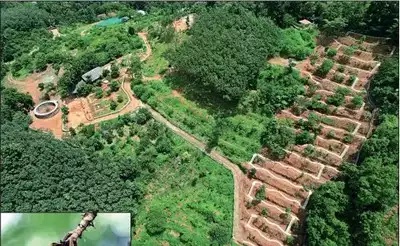Hortus Malabaricus
This is a collection of articles archived for the excellence of their content. |
The book and the garden
As in 2022
Preetu Nair, Oct 30, 2022: The Times of India

From: Preetu Nair, Oct 30, 2022: The Times of India

From: Preetu Nair, Oct 30, 2022: The Times of India
In the early 1670s, Hendrik van Rheede, then governor of Dutch Malabar, conceived the idea of compiling a book on the natural plant wealth of the colony spread across the modern Indian states of Kerala, Karnataka and Goa. The book, Hortus Malabaricus or ‘Garden of Malabar’, took over 30 years and 25 persons to put together, and is the oldest printed book on the subject.
Inspired by the book, a team of four has been painstakingly recreating a garden named ‘Hortus Malabaricus’ over 20 acres of private land in Cheruthuruthy near Kerala’s Palakkad.
Sam Santhosh, the brain behind the project, is a US-based Malayali entrepreneur from Thrissur. Since 2016, his team has collected and planted 678 of the 742 plant species (of which three are repetitions) mentioned in the book. The search for the remaining 61 plants might take another two years, he said.
“Our focus is collection and conservation of the plant species mentioned in Hortus Malabaricus. Along with this, we want to conserve several other plant species found in the Western Ghats, as well as interesting alien plant species that grow here naturally, without artificial support. That includes 29 varieties of black peppers,” Sam said, adding that the Sahyadris (Western Ghats) play a key role in maintaining ecological balance, and as habitats erode they are trying to conserve the last remaining species.
While the team bought some of the plant species from botanical gardens and agro sellers, and sourced some from plant collectors, finding most of the endangered species has taken research and time. For example, plant number 109 in the book – nipapalm (Nypa fruticans) – grows in saline water and was thought to be extinct in Kerala. Efforts to trace it failed until another team member, Anand Gopinath, came across a 2017 paper on it from St Teresa’s college, Ernakulam, that said it had been seen in the district. Anand immediately visited the place but found the 2018 flood had changed the landscape. Luckily, he met a villager who recognised the plant from a photo and led Anand to a nearby paddy field with a cluster of nipa palms. Anand brought a few saplings and replanted them in the garden.
“The most endangered and rare plant species are often found from neglected places, roadsides or railway tracks,” said team member Manoj P, a naturalist. He found Striga asiatica – a rare species of root parasite that needs a host plant to survive at Ashramam Maidan on a visit to his hometown in Kollam district.
Sam, who founded SciGenom Labs and is a managing trustee of SciGenom Research Foundation, had bought the 20-acre rubber estate with a dream to convert it into a medicinal plants garden with a plant genome research facility and an agricultural crop breeding genome centre. But around that time he got introduced to an English translation of Hortus Malabaricus by Padma Shri awardee and taxonomist KS Manilal.
“Why don’t we collect all the plant and flower species in the book, many of which are now endangered in the Western Ghats, and grow them here,” Manoj asked Sam. Sam liked the idea, but he knew that finding the plants wouldn’t be easy as no collection of all the plants and flowers existed in Kerala, although Jawaharlal Nehru Tropical Botanic Garden and Research Institute in Thiruvananthapuram, and Malabar Botanical Garden and Institute for Plant Sciences in Kozhikode had some.
Replanting and conserving the plants wasn’t easy either, as some plants are seasonal and die. Others can’t adjust to the dry climate of the place, so they have set up a greenhouse to ensure the plants they have collected survive. Now they are planning to set up a seasonal nursery where rare plants will be kept for 4 to 8 months to ensure natural regeneration. “Despite all the care, there is still a 20% mortality risk,” said Manoj.
“The maintenance cost is very high. But we want to conserve these plants that once grew naturally in the Western Ghats and are now on the verge of extinction. This would also serve as the future research biobank,” said Sam. Going beyond the book they have been collecting other interesting plants, and the garden now has over 1,500 species. It also has an exclusive section for aquatic and vegetable plants. Due to this, the garden now attracts 120 species of birds and reptiles. There are also many butterflies, so they have also set up a terraced